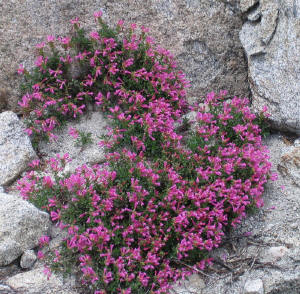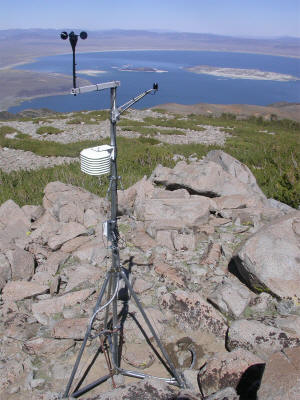Mechanisms Defining Ecological Range Limits
in a Plant Hybrid Zone
Sarah Kimball, UC Irvine
 Hybrid
zones, areas where two divergent populations cross-fertilize producing
viable offspring, can be used to study the mechanisms that isolate
species. Studies of selection in hybrid zones indicate that intrinsic
factors like genomic incompatibilities as well as extrinsic factors like
pollinators and climate can be important in structuring species
boundaries. My study investigates the role of pollinator differences and
physiological trait differences in determining the range limits of
parent species and hybrids. My study system is an extensive hybrid zone
along an elevational gradient. Penstemon newberryi is a perennial
wildflower that grows at mid-elevations throughout the Sierra Nevada
mountain range. Its close relative, P. davidsonii, grows in the
alpine zone in the Sierra Nevada and the Cascade ranges. These two
species form hybrids wherever their ranges overlap, between 3000 and
3400 m elevation in the Sierra Nevada. The two parent species are
somehow maintained as distinct entities with different habitat ranges
despite constant gene flow from the other species.
Hybrid
zones, areas where two divergent populations cross-fertilize producing
viable offspring, can be used to study the mechanisms that isolate
species. Studies of selection in hybrid zones indicate that intrinsic
factors like genomic incompatibilities as well as extrinsic factors like
pollinators and climate can be important in structuring species
boundaries. My study investigates the role of pollinator differences and
physiological trait differences in determining the range limits of
parent species and hybrids. My study system is an extensive hybrid zone
along an elevational gradient. Penstemon newberryi is a perennial
wildflower that grows at mid-elevations throughout the Sierra Nevada
mountain range. Its close relative, P. davidsonii, grows in the
alpine zone in the Sierra Nevada and the Cascade ranges. These two
species form hybrids wherever their ranges overlap, between 3000 and
3400 m elevation in the Sierra Nevada. The two parent species are
somehow maintained as distinct entities with different habitat ranges
despite constant gene flow from the other species.
I am addressing the following four questions:
1. Does intrinsic isolation occur in the stages between pollination and seedling growth?
I conducted a hand-pollination experiment in which the pure species and naturally occurring hybrids were crossed in all possible combinations. Results indicated that the two species hybridized readily, with no reduction in number or viability of seeds resulting from hybrid crosses. The lack of intrinsic isolation indicates that other factors must act to keep the species distinct.
2. Do pollinator differences limit hybridization or the elevational range over which hybrids are found?
I surveyed pollinators at all elevations along my study transect, identifying over 50 species of animal pollinators. Bumblebees were found visiting plants at all elevations, suggesting that they may transfer pollen between species. However, some pollinators, like hummingbirds, hawkmoths, and wasps, were only found visiting individuals along a portion of the elevational transect. Thus, differences in pollinators may limit gene flow between the parent species, but shared pollinators may transfer pollen at all points along the cline.
3. Are there differences in some physiological traits that may define the elevational range limits of the parent species and the hybrids?
I measured physiological traits of both species and hybrids and found differences that correlate to the different habitats of each species. For example, P. davidsonii (alpine species) reached maximum photosynthetic rate at a lower temperature than P. newberryi. Penstemon davidsonii had lower water-use-efficiency than P. davidsonii. Soil moisture increased with elevation and P. newberryi was under greater water stress than P. davidsonii.
 4.
Do parental and hybrid genotypes survive equally well throughout the
hybrid zone?
4.
Do parental and hybrid genotypes survive equally well throughout the
hybrid zone?
I performed a large-scale reciprocal transplant experiment this summer, planting both species and hybrids into three gardens at low, middle, and high altitudes in the Lee Vining canyon. Plants with P. newberryi as the mother did best in the low garden, where P. newberryi naturally occurs. Hybrids did best in the middle elevation garden, and all plant types grew in the high altitude garden. I think that the P. davidsoniii is unable to survive at low elevations because it is too hot and dry in the montane zone, and P. newberryi is able to survive up high, but cannot reproduce in the short growing season of the alpine zone. I plan to continue to study the gardens, measuring physiological traits of garden plants and recording environmental variables.
This study is significant because it helps to explain species diversity. It is unique in its focus on the environmental limits to the distribution of the parent species. Penstemon davidsonii and P. newberryi appear to hybridize freely, raising the question of how they remain distinct as species that occupy separate ecological niches. This study will document how the characters that differ between the two species correspond to pollinators and adaptations to the physical environment. I hypothesize that such traits are involved in maintaining the species. Little modern ecophysiological work has been conducted in hybrid zones, and few studies have combined reciprocal transplant experiments with physiological data to determine the mechanisms by which plant hybrid types succeed or fail at different points along an environmental gradient. I hope to understand an example of the maintenance and origins of biological diversity in Penstemon, a genus that has undergone an explosive radiation into 275 species in the mountains of western North America. Most importantly, my study will elucidate the selection pressures that act to maintain range limits of species that hybridize when their ranges overlap.
